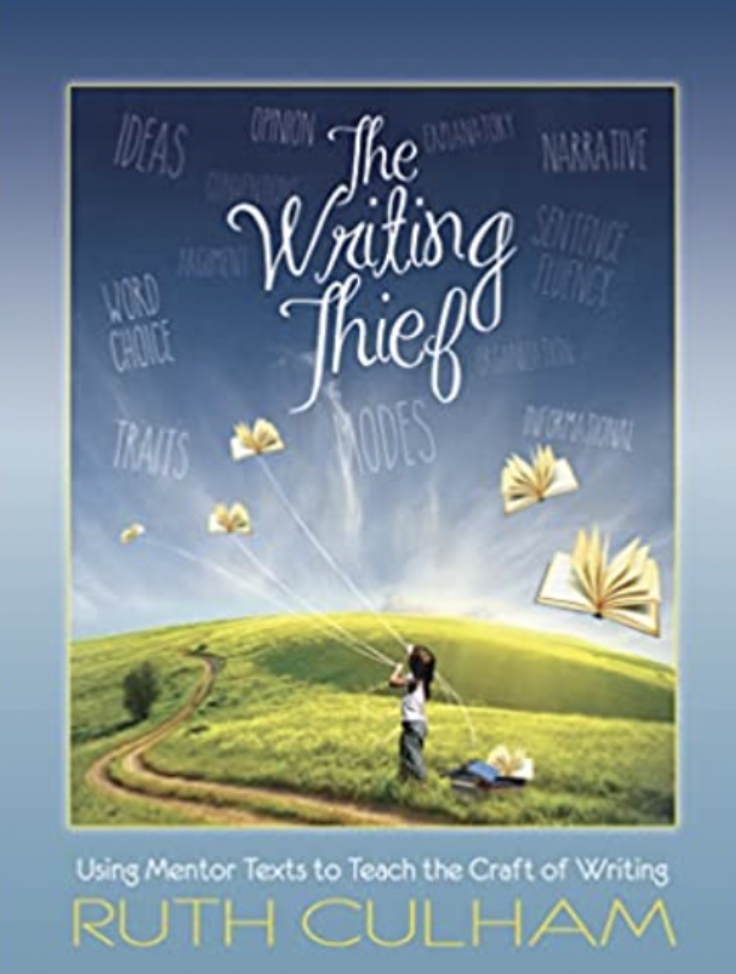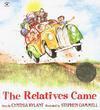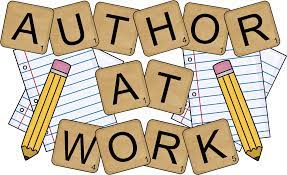
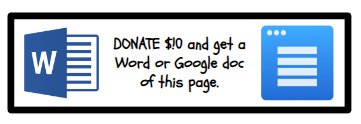

I HIGHLY recommend The Writing Thief by Culham. It suggests mentor texts for every trait for narrative, expository, and persuasive writing.
Here are FREE mentor text lists!
7 Writing Traits
Students should have evidence of these traits in their writing. Help your students make a graphic organizer before writing. It’s best to zoom in on a small moment rather than an I woke up through an I went to bed story.
THE 7 TRAITS ARE HOW WE WRITE and Consists of. . .
Ideas
1. Ideas ~ central message and details, the content Pick a topic. Decide on a title that enticingly captures the theme. Focus on the topic, making it narrow and manageable. Freshly develop the topic with insight and evidence, transcending the obvious and predictable. Use NUMEROUS details to paint a picture in the reader’s mind. The exact information makes the writer credible, especially with believable anecdotes. Be memorable.
Organization
2. Organization: internal structure, a thread of logic, and a pattern of meaning. Create the lead that entices the reader.
Tips for Leads (opening sentence)
- State an interesting fact or thought. Did you know that it is impossible to sneeze with your eyes open? I learned this the hard way. . .
- Ask a question. Did you ever wonder what it would be like if. . . ?
- Make a bold or surprising statement or a promise. It is true; I am a skiing master! This was realized when. . . .
- Give a definition. Dictionary.com defines happiness as pleasure, joy, exhilaration, bliss, contentedness, delight, enjoyment, and satisfaction. I experienced all of this when. . . .
- Start with 3 adjectives. Spooky, creepy, and scary are three words that come to mind whenever I think about last Halloween.
- A quote. In order to succeed, your desire for success should be greater than your fear of failure (Bill Cosby) This rang true for me when. . .
- A flashback. I will never forget that Christmas. . .
- Sound. Chirp, chirp, chirp. . .
- Action. The waves were crashing against the rocks. . .
- Dialogue. Happy birthday! Mom exclaimed as I . . .
- Setting or character description. Be very descriptive, telling time and place. Use senses when describing settings and characters.
- State a problem. Be very descriptive. Use senses.
- Use sequence and transition words to show the reader how the ideas progress, relate and diverge. Develop the body, fitting the details logically, slowing down to highlight important parts and events, and speeding up to move the reader along. End with a sense of resolution and closure.
Tips For Ending Your Story
- Circular ~ end it from the place you began!
- Question ~ ask a thought-provoking question at the end.
- Cliffhanger ~ leave the ending suspenseful and up in the air.
- Hopes/wishes ~ tell the reader your secret hopes and wishes.
- Advice ~ offer the reader a piece of advice.
- Moral ~ tell the lesson that you learned.
- Quote ~ research a quote on the internet around the theme of your story, and end it with the quote. (Remember to say who said the quote!)
Voice
3. Voice: tone and tenor, personal stamp achieved through a strong understanding of purpose and audience. Establish a tone, showing you care by being expressive, compelling, and credible. Convey the purpose to add interest to your overall message. Is this a narrative piece, informational piece, or persuasive piece? Create a connection to the audience. As the writer, you must consider what the reader needs to know and the best way to share this. Take risks to create voice. Be original, fresh, and sound like yourself! VOICE MAY BE THE MOST IMPORTANT TRAIT, SUPPORTING AND EXTENDING WHAT THE WRITER SAYS! VOICE SEPARATES GREAT WRITING FROM PROFICIENT PIECES (Culham, p. 46).
Northern Nevada Writing Project recommends to show:
Your Personality ~ be honest, sincere, have passion and confidence
Your Emotions ~ energetic, heartfelt, your true feelings coming through, invite feelings from the reader, too
Your Style ~ be either a reporter or a storyteller, showcase your techniques, sound like you, take risks
Your Point of View ~ show an emotion, consider perspectives, be aware of your audience, and be sensitive to them
Your Experience ~ know your voice, show insight, sound believable, own the topic
Word Choice
4. Word Choice: vocabulary chosen CAREFULLY to convey meaning. THINK OF THE 5 SENSES. I suggest keeping AABH-SOAP in mind, which stands for the following. Use a thesaurus.
A: Adjectives ~ describe nouns (beautiful, soft, crispy, delicate, rosy, etc.) Be thoughtful and specific. Use your 5 senses!
A: Adverbs ~ describe verbs and usually end in ly (slowly, gently, happily, angrily, quickly). Use your 5 senses. Be specific.
B: Better Words! Instead of said, say replied, whispered, responded, etc. Instead of run, say trotted, sprinted, dashed. Think STRONGER VERBS! Think STRONGER NOUNS! Instead of car, say Cadillac. Instead of “The car drove by,” try “The Cadillac rattled by.”

H-SOAP is the Figurative Language you add to clean up your writing!
H: Hyperboles ~ something that is greatly exaggerated (ate 1,000 pancakes, ran a one-minute mile)
S: Similes ~ compare using like or as (as bright as the sun, like a bull in a china shop)
O: Onomatopoeias ~ sounds like the sound it makes (plop, drip, ring, crash)
A: Alliteration ~ sentence or phrase with same letter sound (sweet smell of success or breezy, blustery day ~ stick one or two in for effect)
P: Personification ~ brings life to nonliving objects (the moon smiled and winked at me, or the chair welcomed me after the long day)
Use words that are specific and accurate. Use language effectively to capture the imagination and create meaning.
By picking the BEST words, you can SHOW, not just tell!
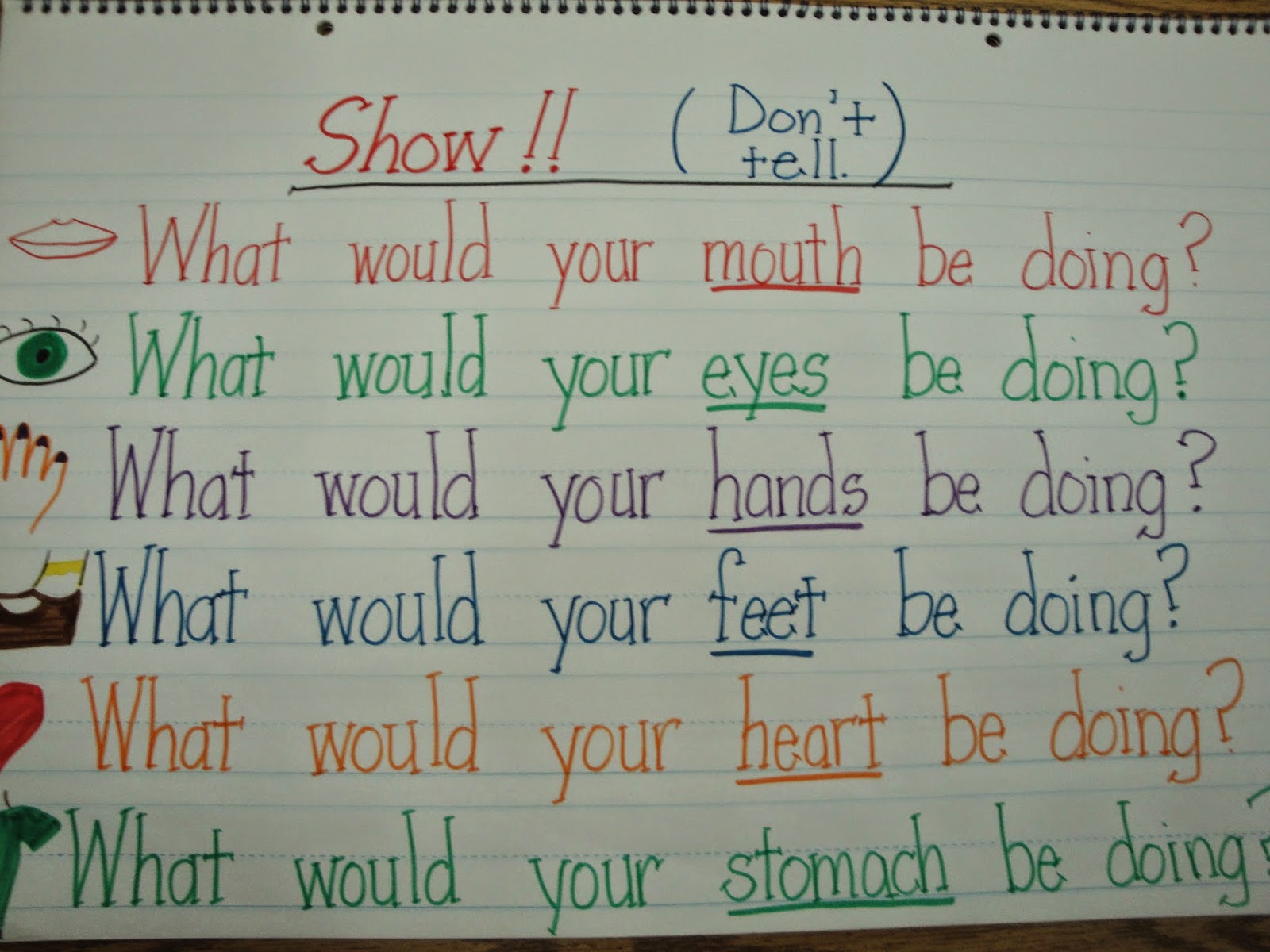
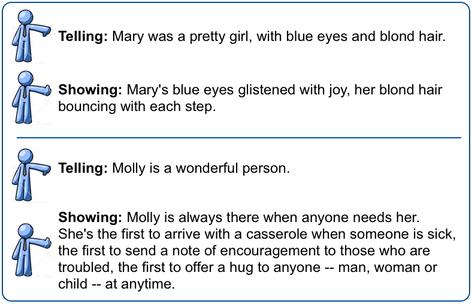
Sentence Fluency
5. Sentence Fluency: the way words and sentences flow ~ the auditory trait because we “read” for it with the ear and eye Capture smooth and rhythmic flow. Read it out loud. How do the sentences sound? Craft well-built sentences and combine sentences using and, but, so, and other transition words. Vary sentence patterns and lengths. Use a one-word “sentence” for effect. Use a mixture of simple sentences with more complex sentences. Have a few sentences answer WHO, WHAT, WHERE, WHEN, WHY, HOW. For example, The man fell. Change this to Yesterday, the lonely older man fell slowly on the dark staircase which led up to the doctor’s office. Break the “rules” to create fluency, especially with dialogue, to make the writing more authentic.
Conventions
6. Conventions: guides reader through the text and makes it easy to follow ~ spelling, punctuation, capitalization, grammar, and usage, paragraphing. Check spelling. Use punctuation and indent paragraphs. Insert capitalization where needed. Check published texts on how to use punctuation and capitalization for dialogue. Apply grammar and usage, only breaking this for stylistic reasons. Otherwise, nouns/verbs should agree.
Presentation
7. Presentation: physical appearance should be visually appealing to invite the reader in. Apply handwriting skills with consistent size, neatness, clearness, and spacing. Use word processing with a clear and appropriate font, using color only to increase readability. Use white spaces, including appropriately sized margins. Incorporate text features that align with the content. For example, there should be no cross-outs or smudges.
ChoiceLiteracy.com (2006-2011) recommends Cynthia Rylant’s The Relatives Came to teach:
- Leads ~ gives a little information about the setting and makes you wonder.
- Endings ~ ease the reader into the conclusion.
- Memoir writing ~ a small slice of life
- Internal thoughts ~ lets us know what the characters are thinking.
- Transition words ~ propels the reader through
- Visualizing ~ word choice, using the 5 senses, helps us
- Sentence variety ~ varied beginnings and lengths
- Voice ~ show ~ don’t tell, write as you talk.
- Beginning, middle, end ~ clear, simple story structure
- Circular story structure ~ this text is similar to If You Give a Mouse a Cookie.
As you read aloud to or with your students, notice what real authors do that your students can do, too!
- 6TraitWritingPosters Use these traits posters!
What is writing?
“Writing is thinking aloud on paper” (Culham, 2014).
“Reading is like breathing in, and writing is like breathing out” (Allyn, 2013, Culham, p. 34).
“In reading, meaning is built from text, and in composing, meaning is built for the text” (Nelson, 1998).
“…writing is a powerful ally and aid to reading. From the very beginning, students need to engage frequently in activities in which reading and writing are paired…” (Michael Graves, Connie Juel & Bonnie Graves, 2007).
Writing is an active, complex process and more than a skill or talent; you cannot be disengaged. We write to learn, and we write to demonstrate understanding. We all are writers ~ whether it is a note to a friend, an email to a coworker or a text to a child, writing is part of our everyday communication. However, writing formally for school is different, and teachers must teach students to write for varied purposes.
Reading and writing are connected and mutually reinforcing. The Common Core State Standards (CCSS) places equal weight on reading and writing and advocates writing in reading assessments. Writing is a means of inquiry and expression for learning in all grades and disciplines. Writing instruction is key to building successful writers. Students learn to write by writing and being taught different genres, processes, skills, and techniques that will allow their writing to grow in much the same way as their reading expands and develops.
The goal of writing is to communicate. However, the power of stories and storytelling predates writing. This video explains Why Writing Matters.
Remember: Writers paint pictures with words!
Write with your heart ~ just for 15 minutes/day! Lives are changed by storytelling.
The Writing Thief
The big message in Culham’s The Writing Thief (2014) is to notice what authors do in the books students read, discuss what authors have done, and ask students how they might try such strategies in their writing. Use mentor texts which is any text, print or digital, that you can read with a writer’s eye (Culham, p. 31). Draw conclusions about how writing is structured (Culham, p. 16).
“Texts are the glue that binds reading and writing processes together. It seems logical, then, to turn to texts to understand writing more deeply rather than relying on worksheets” (Culham, p. 30).
There are 3 Connections Between Reading and Writing
(Lane Clark, University of New England)
- Letter to Sound relationship. Students interact more deeply with phonics when asked to apply it and write!
- Structural level. Writing makes story structure more concrete; we slow down and think about the text differently. Students connect the written word to communication when they write.
- Students are forced to think about language, purpose, audience, and text’s many purposes.
WEAVE THE TEACHING OF READING AND WRITING TOGETHER IN EVERY CONTENT AREA! Reading and writing are connected and mutually reinforcing. The Common Core State Standards place equal weight on reading and writing and advocate writing in reading assessments.
According to The Writing Thief, the following are sensible points for writing instruction (p. 15):
- Practice new skills created by the student, NOT worksheets!
- Develop spelling via high-frequency words, word families, phonics, sight words, and spell check, NOT by formal weekly spelling tests!
- Explore word meanings, NOT assigned vocabulary lists!
- Allow ideas to determine the organization, NOT prescribed formats such as the 5 paragraph essay!
- Teach in the context of reading, skill by skill, moving towards a deeper understanding, NOT skills in isolation!
- Provide choice in format, genre, and mode, NOT assigned topics!
- Evaluate based on performance, growth, and effort, NOT compliance and following directions!
- Use a spiraling scope and sequence that builds each year, NOT covering everything every year!
- Create a happy working classroom, NOT absolute silence!
- Teach test format as a genre, NOT dwelling on test prep!
- Offer small, focused suggestions for revision and editing, NOT marking papers for everything!
- Teach reading and writing together, NOT writing in isolation, focusing on grammar!
According to Culham (2014), the 4Ws of Writing are:
- Writing Process ~ how writing is generated
- Writing Traits ~ how writing works (see 7 traits above)
- Writing Workshop ~ classroom organizational routines
- Writing Modes ~ purpose for writing
The Writing Process consists of the following:
- Prewriting: get a topic and gather resources
- Drafting: commit a rough draft on paper or digital form
- Feedback: get feedback from a reader or listener
- Revision: reflect on feedback and implement changes for clarity, interest, and authenticity. “Revision begins with an evaluation, and the primary reason that students have difficulty revising is that they do not know how to evaluate their writing. . . It is important to teach students specific criteria for evaluation and how to revise based on those criteria” (Graham, MacArthur, Fitzgerald, p. 235).**
- Editing: clean up for conventions: spelling, punctuation, capitalization, grammar, usage, paragraphing
- Finishing/Publishing: create a public copy
Revision Continued REVISING: What are the writers’ goals and purposes for writing? Teach students to self-evaluate their writing using specific criteria related to genre or text structure. See Nonfiction Text Structures.
It might look like this to revise a persuasive essay (Graham, MacArthur, Fitzgerald, p. 222).
- Read the essay.
- Find the sentence that tells what you believe. Is it clear?
- Add 2 reasons why you believe it.
- Scan each sentence. Do they make sense? Are there errors? Can you add more?
- Make changes.
- Reread and make final changes.
Reciprocal Peer Revising:
- Listen to the author read the paper.
- Tell the author what you liked best.
- Read the paper and apply evaluation questions.
- Discuss suggestions.
- The author makes changes.
The Writing Modes
THE MODES ARE WHAT WE WRITE! Different purposes for writing ~ narrative, expository, persuasive. Purpose drives the reasons students write and is key to helping students understand what they are writing.
Writing can (Lane Clark, University of New England):
- Cause knowledge to become organized and coherent
- Reinforce and extend learning
- Facilitate learning to read
- Slow down our thinking
- Practice a critical lifelong communication skill
According to the Common Core, writing should always be PURPOSE DRIVEN and well-crafted. Traits and mode work hand in hand (Culham, 2014, p. 26):
Narrative: to write real or imagined experiences or events using effective techniques, well-chosen details, and well-structured event sequences (to tell a story)
Informational/Explanatory to examine and convey complex ideas and information clearly and accurately through the effective selection, organization, and analysis of content (to explain, describe, inform) Traditionally labeled expository.
Argument (opinion): to write arguments to support claims in an analysis of substantive topics or texts using valid reasoning and relevant and sufficient evidence (to convince using logic and reason)
PEER EDITING ~ always stay positive! Peer editing is FUN!
- Compliment ~ start with positive words!
- Suggestions ~ suggest specific word choices, discuss unclear or confusing parts, and talk about leads, clinchers, and sentence structure (lengths, vary sentence beginnings).
- Corrections ~ spelling, grammar, punctuation, complete sentences
Writing Teaching Tips
Have specific, concrete teaching objectives: Do not say, “I am teaching the ideas trait,” but rather, “I am teaching students to focus and narrow their topics within the ideas trait” (Culham, p, 49). Jeremy Sherman said, “To name it is to tame it,” meaning that if we can name what is not working in children’s writing, we can tame the same quality in our work with students and, conversely, name what is GOOD about their writing to encourage more of it (Culham, p. 44). We all need to use the same writing language for consistency.
Mentor texts: Mentor texts do not need to be picture books. Consider short passages from chapter books, menus, and advertisements.
The importance of poetry: Author, Nicola Davies, said most poetry is observational nonfiction, delivering a sensory and emotional experience about the world in a narrative package (Culham, p. 48). “Poetry has a memorable shape and feel, a manageable carrier for the information it contains” (Culham, p. 48).
QUICK WRITES ARE BENEFICIAL!
PLANNING THE WRITING ~ differentiate instruction by teaching choices in planning.
There are 2 broad approaches to planning ~ top-down, in which the student uses concept maps and outlining. . . and bottom-up, in which the student writes freely with extensive revision. Chapter 8 in Best Practices in Writing Instruction, 2nd Edition (2013) outlined the best practices in planning writing:
1. Contemplate the task and the writing ~ Is there a text structure to follow (for ex. cause/effect)? Is there a rubric? Is there a specific length? Audience? Purpose?
2. Activate prior knowledge ~ How do your feelings influence the topic? What do you know? What do you need to research?
3. Consider vocabulary and language use ~ Vocabulary choices reveal knowledge about the topic.
4. Organize ideas ~ Think about how the reader will understand.
5. Continue to plan ~ writers are constantly revising and filling in the gaps ~ this is STILL planning.
Teach Planning Strategies
These strategies need to be taught, so students have options and pick what planning strategy works best for them! Planning can be fun and EXCITING!
Simply Think ~ Model thinking aloud, jotting down ideas
Inquiry ~ Students start by writing questions about the topic as a writing plan (Graham, MacArthur, Fitzgerald, p. 207).
Sketch Journals ~ Sketching can help spark descriptive vocabulary when the writer draws the character and setting as a planning strategy (Graham, MacArthur, Fitzgerald, p. 208).
Graphic Organizers ~ Drawing slows us down and helps us notice ~ critical skills for writers (Ernst daSilva, 2001), (Graham, MacArthur, Fitzgerald, p. 208). Students should revise their content maps/graphic organizers as their thinking changes.
Free Writing/Quick Writes ~ Students write for a chunk of time without worrying about spelling or punctuation. Students must have a lot of background knowledge to do this.
Talking into a Tape Recorder ~ Tell your story aloud on tape, then transcribe it. ELLs can record their story in their native language (Graham, MacArthur, Fitzgerald, p. 208).
3×5 Note Cards ~ Place information on separate index cards, then group the cards by related information, which is helpful for kinesthetic learners (Graham, MacArthur, Fitzgerald, p. 209).
Outline ~ Good for linear thinkers (Graham, MacArthur, Fitzgerald, p. 209).
Technology ~ Students can write in Word and revise/plan as they go. There is an outline feature on Word that helps students plan their writing before and after drafting (Graham, MacArthur, Fitzgerald, p. 209).Â
TEACH SENTENCE COMBINING! Sentence combining is an effective technique to increase students’ ability to manipulate syntax (Graham, MacArthur, Fitzgerald, p. 254). It is best taught in a well-rounded writing program that includes ample time for writing, conferencing between peers and teachers, mini-lessons to increase skills, ample teacher modeling, and choice in writing assignments (Graham, MacArthur, Fitzgerald, p. 255).
MENTOR TEXTS FOR WRITING
To quote Graham and Perin (2007), “Writing well is not just an option for young people – it is a necessity. Along with reading comprehension, writing skill is a predictor of academic success and a basic requirement for participation in civic life in the global economy” (Culham, p. 10). In The Writing Thief, Culham points to a lack of consistency and continuity in the teaching of writing in the past (p. 12). We also need to test less ~ texts, not test! (Culham, p. 12). There needs to be much immersion in literature, combined with a writing program based on essential writing skills that deepen over time, becoming more complex and integrated throughout the years (Culham, p.13).
A QUICK FYI: LETTER FORMATION IS IMPORTANT! Students who form letters correctly and have a firm grasp of spelling will have an easier time writing. In combination with poor spelling, poor handwriting can contribute to disability in written expression (Graham, Harris, & Fink 2000, Graham, MacArthur, Fitzgerald, p. 276). Failure to develop automatic and legible letter and word formation may interfere with content in writing (Jones & Christiansen, 1999, Graham, MacArthur, Fitzgerald, p. 276). Students devoting too much time to letter formation or retrieval have less time for spelling, planning, and expressing themselves.
Copyright 02/22/2015
Edited on 04/28/2023
References
Culham, Ruth. The Writing Thief: Using Mentor Texts to Teach the Craft of Writing. Newark: International Reading Association, DE. Print.
Graham, Steve, Charles A. MacArthur, and Jill Fitzgerald. Best Practices in Writing Instruction, Second Edition. New York: Guilford, 2007. Print.
Copyscape alerts me to duplicate content. Please respect my work.
![]()

